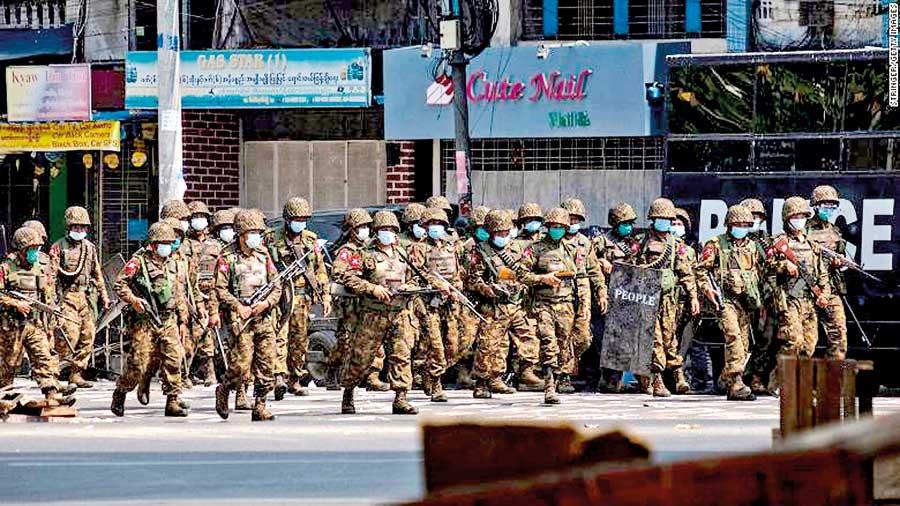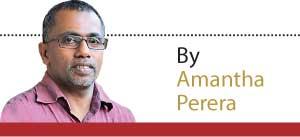Reply To:
Name - Reply Comment
Controlling information and soldiers in the age of social media

The Myanmar coup - military in action
I was just driving out of Kandy on work when I received the first indication of something was not right on April 21, 2019.
2019.
It was a slumberous morning and early at dawn, the Kandy Lake had been blanketed by a thick fog.
The first messaged on WhatsApp said that there was an explosion at St Anthony’s Church, Kochchikade.
That the message arrived on the social messaging platform and not as an SMS was significant.
During the peace interlude between the end of the war in 2009 and the Easter Sunday carnage in 2019, the once-ubiquitous SMS had been replaced by the WhatsApping as the platform of choice.
During the war also there were information networks, but these were cumbersome to operate. Messages needed to be forwarded and it cost money. Their very operational nature limited them. Not so with the social media apps.
WhatsApp had made it easier and cheaper to send messages. That in turn also assured that just about anybody could do this. Connectivity, smartphones and digital platforms had combined effectively and dangerously.
Initially, some speculated that it was a transformer blast. Soon the messages started appearing at a frenetic rate that it was clear this was not some accident. Far frenetic than anything I had seen before or since.
As I doubled back to Colombo, social media messaging apps were my main and possibly the most reliable information conduit.
But I had to navigate the labyrinth with caution weeding out the fakes from the real. This was particularly true when documents laying bare the intelligence failure began to appear.
My experiences and training as a journalist had imbued an internal system of scepticism on any information
I receive.
"It is not so easy when the foot soldiers are on Facebook where each one inhabits a different eco-system and an algorithm halfway across the world could spring dreaded morsels of information of the protests on to their social media profiles simply because of a mathematical formula"
At journalism school in the US, I was told to get two sources to verify every morsel of information. Newly supplanted from Sri Lanka I found this impossible to do sometimes. It was the first time I had been asked to do this, but from then on it became a habit.
I bring the same habit to any information I get. This has helped me to keep myself safe from falling prey to fakes and misinformation. But I consider myself an information expert, most others are not and don’t have the same internal trip-wire system.
Social messaging platforms came really into prominence around six months before the attacks among Sri Lanka journalism circles when then-President Maithripala Sirisena sacked his Prime Minister Ranil Wickremesinghe.
As State media blocked anything and everything to do with the sacked PM, their private counterparts played the usual political game of supporting whomever they thought fit.
It was with the coup that we first witnessed Facebook and Twitter being used by various political players to cut out the interlocutor and gain access to an audience. Ironically, the pioneer in using social media for political propaganda work in Sri Lanka was none other than Mahinda Rajapaksa.
It was the current PM, who as President who first used Twitter and Facebook as an engagement tool.
Social media has become the indispensable information facilitator. The pandemic and lockdowns only accelerated what was inevitable.
We see the military junta in Myanmar playing tricks with social media, throttling and filtering networks. I have been told that the on, off nature of connectivity in Myanmar since the February 1 coup may not be only to keep information from circulating among the tens of thousands of protestors, some 700 of whom have paid with their lives.
The blocks may also be to keep information out of circulation from those bearing the weapons. It was easier to keep the military within a singular political drumbeat when there were no social media and you controlled whatever media was there.
It is not so easy when the foot soldiers are on Facebook where each one inhabits a different eco-system and an algorithm halfway across the world could spring dreaded morsels of information of the protests on to their social media profiles simply because of a
mathematical formula.
The writer is a journalism researcher and a writer. He can be contacted at
[email protected]